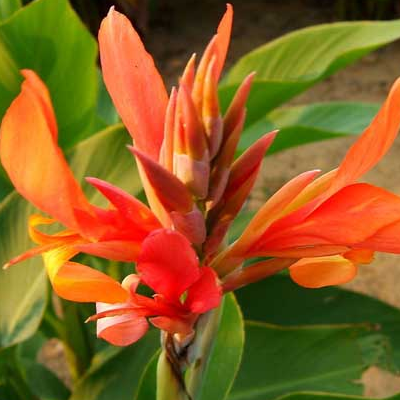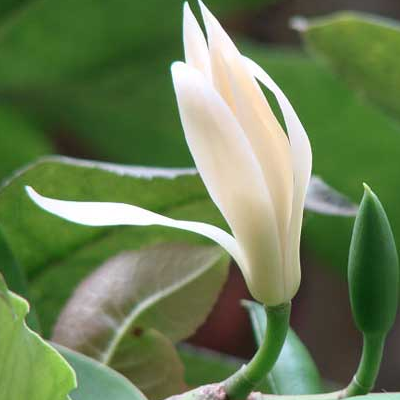Can canna eat? what are the breeding methods?
Canna is a plant with great greening value and is very suitable for breeding, so can canna be eaten? What are the breeding methods of canna?

Can canna be eaten:
Some varieties are edible. Some are not allowed.
Canna is a perennial perennial herb, native to America, with more than 50 varieties in the world. In addition to ornamental, some are also edible, called edible canna.
Edible canna is also known as canna taro and banana lotus root. Its rhizome is fleshy and rich in starch; the leaves are broad, long oval-lanceolate, 40 cm long and 20 cm wide, and the green leaf margin is sometimes purple; racemes terminal, inflorescences about 7.5 cm long, red, lips yellow, flowers and leaves can be ornamental.
What are the breeding methods of canna:
1. Sowing and reproduction
Before sowing, the canna seeds should file a hard seed coat, then soak it in 25 ℃ water for 24 hours, and then sow it in plain sandy soil. The covering of the soil should not be too thick, and it should be 1-2 times the seed diameter. After sowing, keep the soil moist at a temperature of about 20 ℃. After a week, it can germinate, and when the seedling height is 5 cm, it can be planted separately.
2. Rhizome propagation
The rhizome of canna usually propagates at the beginning of March every year. The rhizome stored in the previous year is cut into pieces, the rotten part is removed, each piece has two or three bud holes, and then it is planted directly in a flowerpot or buried in plain sand. Pay attention to keep the soil moist and keep the temperature between 10 and 15 degrees. About 20 days, when the bud is 4-5 cm long, it can be divided into pots.
3. Ramet propagation
Canna plantlets are usually propagated on cloudy and rainy days from June to July or in the evening. If the distance between plants or clumps is more than 4-5 cm, cut down vertically from plants with sharp tools, split plants or clumps quickly, pay attention to more soil, do not damage branches and leaves, and then plant directly into the planting hole, water thoroughly in time after planting, and properly shade the sun to increase humidity if the environment is relatively dry. After about 10 days of maintenance, the new plant can not develop into a complete plant.
All right, boys and girls, we all know that we can eat.
How to cultivate Canna Canna Culture methods and skills
There may not be many people growing canna, but in fact, planting canna requires some attention. Next, let's introduce the culture method of canna to you.
Culture methods of canna
I. the culture method of canna-- morphology
Canna is a relatively low plant with a beautiful shape and a variety of colors. The viewing degree of canna is extremely high, and it is very beautiful surrounded by dense clusters.
Second, the culture method of canna-- habit
Canna likes the high temperature environment, and the humid and hot climate is suitable for growing canna. The temperature of canna should be controlled at about 32 degrees Celsius. Once the ambient temperature is lower than 20 degrees, the flowers will be less likely to bloom. When the temperature is lower than 0 degrees, the problem of freezing injury will occur slowly.
Third, the culture method of canna-sowing
Canna can be collected in winter to ensure that it is most appropriate to sow in spring. Winter seeds need a warm environment to keep warm and prevent frost damage, and it is best to sow seeds and wait for germination at warmer temperatures. The general time of germination is about 25 days.
IV. The culture method of canna-cutting
Canna can also choose cutting methods. Spring and summer is a good time for cutting. Choose strong branches, which are about 10 centimeters long. Plant them in an acid sand bed and wait for 40 to 50 days to slowly take root. Pay attention to insect pests.
Culture methods of canna
Canna, alias: big flower canna, red banana, blue banana, are commonly used flowering plants in the subtropics and tropics, and now they are also introduced in the north, such as Shandong, Anhui, Jiangsu, Henan and Hebei. Banana family, Banana genus perennial herbs, 1-2m high, plant glabrous, with stout rhizomes, for ginger order, banana family. Flowering: summer and autumn, flower words: solid future, color: White, red, pink, yellow, miscellaneous. Native to India, it is now often cultivated in the north and south of China.
Canna likes warmth and plenty of sunshine and is not resistant to cold. It is not strict with the soil, and it grows best in the loose and fertile sandy soil with good drainage, and it is also suitable for the growth of fertile clayey soil.
Fertilizers are often applied during the growing season. In the north, underground tubers should be dug up before frost and stored in an environment with a temperature of about 5 degrees Celsius. Because of its large and colorful flowers, rich colors, good plant shape, easy cultivation. The optimum temperature for open field cultivation is 13-17 degrees Celsius. It is not strict with the soil, and it grows best in the loose and fertile sandy soil with good drainage, and it is also suitable for the growth of fertile clayey soil. The south of the Yangtze River can spend the winter in the open field in the windbreak. Branch propagation or sowing reproduction. Ramet propagation was carried out when the bud eye began to sprout from April to May, and the rhizome was cut and planted with 2-3 buds per segment.

Frost flowers and leaves wither.
Banana is a perennial bulbous rhizome herb with stout, fleshy rhizomes lying in the ground. In warm areas, there is no dormant period, which can grow throughout the year, and it is most suitable to grow at 22-25 degrees Celsius; 5-10 degrees Celsius will stop growing, and frost injury will occur when it is below 0 degrees Celsius. Because canna likes to be moist and avoid dryness, in hot summer, if it is hit by the hot sun or the dry and hot wind, the leaf edge will scorch; the same phenomenon will occur if it is overwatered.

- Prev

How much is the banana pot? what are the culture techniques in a pot?
Canna is a perennial perennial herb, native to Anglo-American and India, and later widely planted in China, so how much is it per pot? What are the techniques of canna pot culture? How much is the canna plant per pot: the sapling of canna is 0.4 yuan per plant, which is still relatively cheap.
- Next

What is the difference between the propagation methods of white orchids and magnolia?
The florescence of the white orchid is very long, and the fragrance of the flower is also very strong, so what are the breeding methods of the white orchid? What's the difference between white orchids and magnolia? What are the propagation methods of white orchids: sowing and breeding, sowing and raising seedlings at the end of September or early October, picking the ripe fruit and taking out the seeds
Related
- Fuxing push coffee new agricultural production and marketing class: lack of small-scale processing plants
- Jujube rice field leisure farm deep ploughing Yilan for five years to create a space for organic food and play
- Nongyu Farm-A trial of organic papaya for brave women with advanced technology
- Four points for attention in the prevention and control of diseases and insect pests of edible fungi
- How to add nutrient solution to Edible Fungi
- Is there any good way to control edible fungus mites?
- Open Inoculation Technology of Edible Fungi
- Is there any clever way to use fertilizer for edible fungus in winter?
- What agents are used to kill the pathogens of edible fungi in the mushroom shed?
- Rapid drying of Edible Fungi

